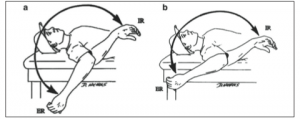Brian Schiff’s Blog
Injury Prevention, Sports Rehab & Performance Training Expert
It is no secret that elbow injuries have been on the rise in MLB as well as all levels of baseball. I see far too many adolescent baseball pitchers in my clinic with medial elbow pain. Often it is related to pathological GIRD and proximal imbalances in the shoulder complex.
Researchers have been studying biomechanics for years. It has long been a belief that younger pitchers should focus on fastballs and change-ups, while minimizing curveballs. Currently, the prevailing thought and latest evidence seems to suggest that velocity may be the bigger risk factor or determining factor in leading to UCL injuries.
A paper in the August 2016 edition of the American Journal of Sports Medicine from Rush University Medical Center sought to determine factors associated UCLR among MLB pitchers. The hypothesis was that those pitchers who underwent UCLR would have a higher pre injury pitch velocity.
This retrospective case controlled study looked at data for pitch velocity, type and number for every pitcher and game were gathered from the PitchFx database from April 2, 2007 to April 15, 2015. Data from 2013 – 2015 was excluded to avoid lead in time bias, as pitches in these seasons may contribute to injuries in pitchers who have not yet undergone UCLR. Pitchers were classified as control, pre injury or postoperative.
I see plenty of pitchers in my clinic ranging from 12 y/o travel baseball players to MLB guys. My own son is a left handed pitcher so I am always carefully watching his mechanics, pitch count and arm care. There has been much written about glenohumeral internal rotation deficit (GIRD) and total shoulder motion over the years.

Today, I wanted to recap a nice article that was recently published in the American Journal of Sports Medicine by Wilk et al. looking at deficits in glenohumeral passive range of motion (PROM) and the increase in elbow injury risk.
This prospective study was done over an 8 year period from 2005-2102 and looked at PROM of both throwing and nonthrowing shoulders of all major and minor league pitchers within a single baseball organization. The measurements were taken with a bubble goniometer during spring training. See images below from the journal article for how measurements were taken:

In sum, 505 exams were performed on 296 pitchers. Motion was assessed in supine with the arm abducted to 90 degrees and the arm in the plane of the scapula. One examiner stabilized the scapula, while another measured total rotation and passive flexion. Elbow injuries and days missed because of injuries were assessed and recorded by medical staff. Throwing and nonthrowing measurements were compared, while additional testing was done to find significant associations between shoulder motion and elbow injury, as well as odds of an elbow injury.


